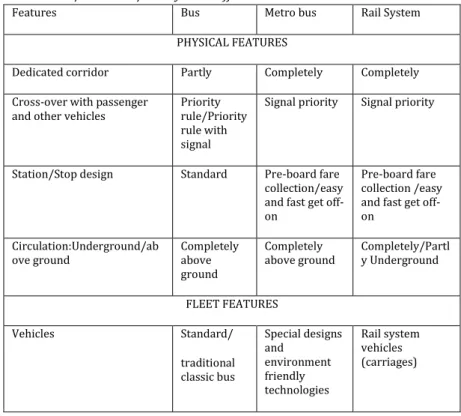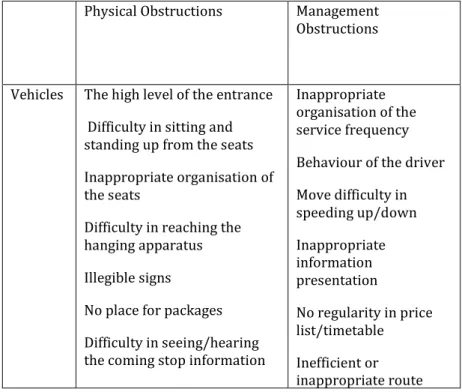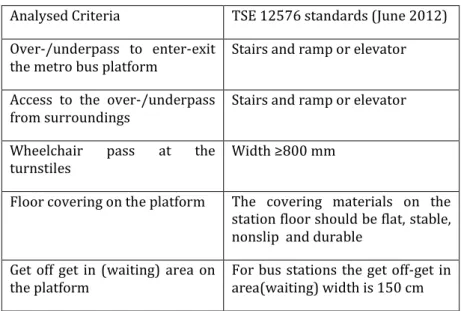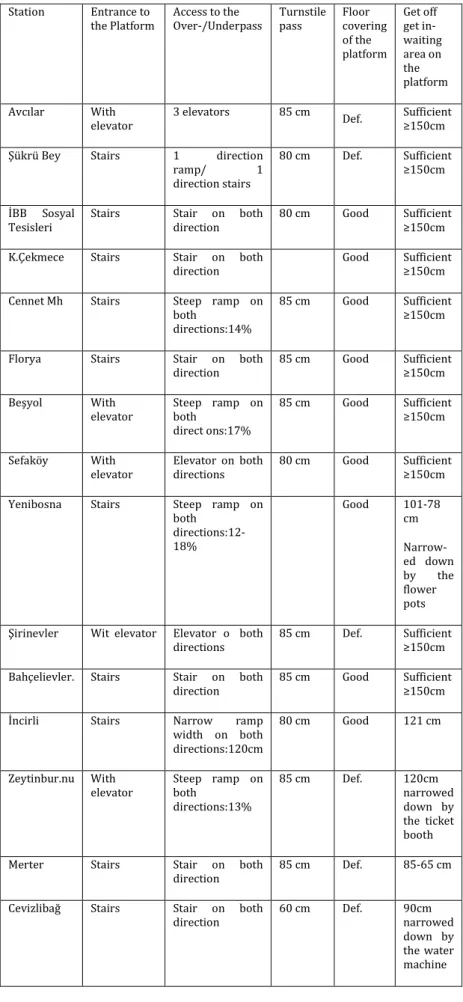IC
ON
A
RP
International Journal of Architecture and Planning
Volume 2, Issue 1, pp: 70-81
ISSN: 2147-9380
available online at: www.iconarp.com
al Jour na l of A rc hite cture a nd Pl an ni ng
Abstract
Every day, in urban areas, the mobility of people and goods forms inner urban transportation. When urban transportation is carried in the form of public transportation, it becomes a public service. The urban public transport is one of the important services for all citizens since it is a public service provision. This service is provided by local government and it has been offered as a service without any distinctions between young, old, children, men, women, disabled, employee or retired or briefly to the society. Additionally, traffic congestion and the expence of owing and maintaining vehicles increase public transport usage in cities.
Wheelchair Users’
Accessibility Problems in
Public
Transportation-Case of Metro Bus
Ayşe Nilay EVCIL
S. Selhan YALÇIN USAL
Keywords:
Accessibility, wheelchair user, public transportation, metro bus (bus rapid transit)
Ayşe Nilay EVCIL, Assoc. Prof.
Beykent University, Department of Architecture, İstanbul, Turkey
E-mail: nilaye@beykent.edu.tr
S. Selhan YALÇIN USAL, Assist. Prof.
Haliç University, Department of Interior Design, İstanbul, Turkey
71
na l of A rc hite cture a nd Pl an ni ngIn populous cities, spread over a wide area like Istanbul, urban public transportation improves the quality of urban life. Therefore, public service should aim to provide qualified, safe and accessible provisions. In this study, we examined the accessibility problems faced by wheelchair users when they travel through metro buses in urban transportation. As a result, the metro bus system used for 6 years in Istanbul urban public transport is not accessible for everyone even it is a new vehicle. This result shows the failure of metro bus to fulfil the requirement of law 5378. It is essential to provide equal services to citizens in order to take social sustainability. Everyone must receive immediately the chance of living of human dignity. At least accessibility must be provided in all public services after the adaptation of law 5378 in 2005. Additionally, all sanctions must be identified and implemented in each inadequately accessibility provision.
INTRODUCTION
In cities, humans are continuously on the move. If we add the move of objects to this, we talk about the intercity transportation. In intercity transportation, public transport service for all citizens, offered by local administration, is a public service. Therefore, local government has to offer equal, fair and accessible service to every individual of the society. “The aim of the intercity transportation is to offer travel in a city at the lowest cost both for users and operators and the highest contribution to the social development. One of the important elements of this system is public transport” (Evcil, 2007, p.275). At the same time, transportation possibilities are one of the factors that increase or decrease the life quality of the individuals. In Turkey in the year 2000, 2235 subjects were asked about their opinion on quality of life factors. With many factors it was found that public transportation possibilities are contributing the individual’s life positively. (EvcilTürksever, 2001)
Spatially, cities expanded due to the population increase and the development of public transport system. This urban expansion has some negative impacts on intercity transportation. The transportation quality, acceptable time limit and cost are at the top of these problems. In recent years a new problem under the topic of accessibility was added to them. In the US in 1990, after the Americans with Disabilities Act (ADA) was accepted, especially the opinion that the most natural right of an individual is the accessibility of public service and usage of public areas was accepted and applications about this topic were in many states supported by laws. This situation is secured in Turkey by laws. The discrimination is unacceptable at any level, especially providing accessibility of public areas and benefit from public service is underlined at first in the 5378 numbered Law (Özürlüler ve Bazı Kanun Hükmünde Kararnamelerde Değişiklik Yapılması Hakkında Kanun,2005), the development plan law and in many regulations. As a public service, provided and supervised by the local administration, the intercity public transportation makes after the temporary 3rd article of the 5378
al Jour na l of A rc hite cture a nd Pl an ni ng
72
numbered law essential to take the required precautions for the usage of disabled individuals.
In this work, the public service of the metro bus that was put in Istanbul into service in 2007 for the ease of intercity transportation will be analyzed especially from the view of wheelchair users. The providing - non-providing success of accessibility of the metro buses which were put into service after the 5378 numbered law will be discussed.
INTERCITY TRANSPORTATION SYSTEMS AND METRO BUS
It is possible to classify the intercity transportation systems into highway, seaway and rail systems. In the recent years it is observed that the so called bus rapid transit vehicles, which we translated as metro buses are added into the public transportation of big cities. The metro bus is substantially a rubber-tired vehicle working in a dedicated lane system. The difference to traditional busses can be explained as the increasing number of passenger capacity, except of its specific stops the continually circulation on ways for only metro buses and separated from other vehicles and taking the cost of the passengers before entering the vehicle. Due to these reasons it is defined to be faster and having more passenger capacity than buses and it is also called as rubber-tired ground metro (Acar, undefined date). To sum up, the metro bus is in comparison to rail system lower prized, to bus faster and more environment friendly and it is a vehicle combined of the elements of metro and bus (Table 1).
Table 1. Bus/Metro bus/Rail System Differences.
Features Bus Metro bus Rail System PHYSICAL FEATURES
Dedicated corridor Partly Completely Completely Cross-over with passenger
and other vehicles Priority rule/Priority rule with signal
Signal priority Signal priority
Station/Stop design Standard Pre-board fare collection/easy and fast get off-on
Pre-board fare collection /easy and fast get off-on
Circulation:Underground/ab
ove ground Completely above ground
Completely
above ground Completely/Partly Underground FLEET FEATURES Vehicles Standard/ traditional classic bus Special designs and environment friendly technologies Rail system vehicles (carriages)
73
na l of A rc hite cture a nd Pl an ni ng MANAGEMENT FEATURES Station/stop frequency Busstandards Rail system standards Rail system standards Station/Stop quality Standard Rail system
standards Rail system standards Way and line structure Open to all
lines Only open to main line Only open to main line Trip frequency Infrequent
because open to all lines All 5-10 minutes a main line All 5-10 minutes a main line Terminal quality Standard Encourage
transfer Encourage transfer Ticket technology Standard Fast pay
technology allowing transfer Fast pay technology allowing transfer Line number passing the
station-stop Free Only 2-3 mainline Only 2-3 mainline Regularity audit (observation
to timetable) Free Real time central observation
Real time central observation Passenger information
system Not necessary Real time central control Real time central control Customer satisfaction If the
management is good, moderate
High High
(Source: Acar, date not mentioned, p.94)
PUBLIC TRANSPORTATION WITH METRO BUS IN ISTANBUL
With the growing of cities in land and population, inaccessibility of pedestrians between the distance of workplace and housings, the local governments start to search new transportation systems to solve this problem. So, in the second half of the 19th century, public transportation solutions has tried to put into service against the private vehicle use. At that time the first public transportation development has operated with the rail systems. The first examples of them can be seen with the steam train in London in 1860 (Renda, 1996). In fact, also Istanbul has met the rail system at that time, the tunnel between Karaköy-Şişhane has put into service in 1875, but until 2000 this route could not be developed and new rail systems could not be used. The tram and the trolley have operated until the 1960s, could not take the place of the metro network of modern and big cities.
The metro bus is the newest vehicle added in 2007 to Istanbul’s public transportation system. The first line is the part between Topkapı and Avcilar. Avcılar-Zincirlikuyu and Zincirlikuyu-Söğütlüçeşme lines have followed the first one. The last part on that line, Avcılar-Beylikdüzü, has put into service in 2012. Between Beylikdüzü and Söğütlücüçeşme the travel takes
al Jour na l of A rc hite cture a nd Pl an ni ng
74
83 minutes (in one way). Metro bus is used between both continents, carries 700.000 passengers in average a day through 45 stops between a 52 km line, shows it is an important element of the public transportation of the city (anonymous, 2013). Because the metro bus line is in the middle of the east-west highway D-100, the access is provided through over- and underpasses with stairs.
ACCESSIBILITY IN PUBLIC TRANSPORTATION
“The term accessibility expresses the ability to go anywhere and to reach every open and closed built-up area’s” (Evcil, 2010, p.1864). It is an important element of man-made environment and at the same time a human right accepted by the United Nations. Moreover, all accessible designs are also be used by the elderly and by parents with children in prams (Sürmen, 2004).
Accessibility in built environment should be evaluated like rings of a chain, in the situation of the absence of one ring may damage accessibility provisions. In other words, pedestrian paths in a city, the public transportation vehicles and stops and buildings (especially public ones) should be designed for the liberally and fairly usage of an individual without confronting any physical obstruct.
The accessibility problems faced in the physical environment can be categorized from the point of different user groups (like wheelchair users, blind people, elderly people, people with crutch etc.) and from the properties of the physical environment (like architectural scale or urban scale). Because in this work, the accessibility problems in public transportation are discussed, the problems in public transportation can be defined as in Table 2.
Table 2. Problems Encountered By the Disabled in Public Transportation.
Physical Obstructions Management Obstructions
Vehicles The high level of the entrance Difficulty in sitting and standing up from the seats Inappropriate organisation of the seats
Difficulty in reaching the hanging apparatus Illegible signs
No place for packages Difficulty in seeing/hearing the coming stop information
Inappropriate organisation of the service frequency Behaviour of the driver Move difficulty in speeding up/down Inappropriate information presentation No regularity in price list/timetable Inefficient or inappropriate route
75
na l of A rc hite cture a nd Pl an ni ngAbsence of the other visual signings
*Absence of detectable warnings
*Unreachable buttons *Absence of braille letters on the buttons
planning
Too many transfer
Facilities Long stairs
Long walking trails
Inappropriate fare collection equipments
Inappropriate information equipments
Absence of crowd reducing equipments
Insufficient seats
Insufficient transfer to other transportation types * Inappropriate design of the stop to enter the vehicle * Turnstile at the pass to the platform
*Absence of detactable warning lines
*No ramp or elevator to reach the platform
*Not reaching the ticket machines
* Insufficiency in the indoor design of elevators
Help/behaviour of the worker
Inadequate information for passenger
Not guiding the crowd flow
Insufficient transfer to other transportation types
*Non usage of the Braille alphabet on printed tariff
Source: mentioned in Gümüş, D. 2001, pp. 76-78, for the original source look at US Department of Transportation 1973
*Not included in the original text, added problems after the observations in Istanbul, 2013
FIELD STUDY: PROBLEMS OF ACCESSIBILITY TO ISTANBUL METRO BUS FACED BY WHEELCHAIR USERS
In this work, the accessibility problems faced by wheelchair users in Istanbul metro bus, is analyzed. Every disabled group has with the accessibility different needs. In this work, the physically disabled accessibility problems were researched, because they are thought to be the most
al Jour na l of A rc hite cture a nd Pl an ni ng
76
disadvantages, reasoned by their moving difficulties. This line contains 26 stations. This research is a descriptive analysis, so the accessibility problems were signified by making observations and measurements in every station. In every station 5 criteria about the physical features of metro bus in Istanbul, TSE 12576 (Intercity Roads-Street-Main Street for Handicapped and Elderly People, Design Rules for Precaution and Signing on Squares and Roads) criteria were taken. Values/statements shown on these criteria and standards are (Table 3):
Table 3. Accessibility Criteria and Standards of TSE 12576.
Analysed Criteria TSE 12576 standards (June 2012) Over-/underpass to enter-exit
the metro bus platform Stairs and ramp or elevator Access to the over-/underpass
from surroundings Stairs and ramp or elevator Wheelchair pass at the
turnstiles Width ≥800 mm
Floor covering on the platform The covering materials on the station floor should be flat, stable, nonslip and durable
Get off get in (waiting) area on
the platform For bus stations the get off-get in area(waiting) width is 150 cm
The wheelchair users’ accessibility on the Avcilar-Zincirlikuyu metro bus line evaluation results were shown in Table 4. The researchers are made in April 2013.
As it is understood from Table 4, most of the stations have no elevators or improper ramps. Elevators are provided only in 8 stations (1 elevator is out of order)(30,7 %) (Avcılar, Şirinevler, Zeytinburnu, Okmeydanı, Mecidiyeköy, Zincirlikuyu, Beşyol, Sefaköy). 4 stations are in partly (15.3%) accessible situations, because the floor covers of the platforms are defective or the common waiting platform width is under the standards. Only 2 of the evaluated stations (Sefaköy, Zincirlikuyu) can be qualified as probable to the criteria (%7,7). Additionally, because in some stations (like Edirnekapı), whereas an elevator going to the platform is available, the access to the overpass is provided by stairs, thus the accessibility is not accepted. In one station a platform lift is provided, but during the observation it is out of order.
77
na l of A rc hite cture a nd Pl an ni ngTable 4.The Accessibility of Wheelchair Users on the Avcilar-Zincirlikuyu Metro
Bus Line.
Station Entrance to
the Platform Access to the Over-/Underpass Turnstile pass Floor covering of the platform Get off get in-waiting area on the platform Avcılar With
elevator 3 elevators 85 cm Def. Sufficient ≥150cm Şükrü Bey Stairs 1 direction
ramp/ 1 direction stairs
80 cm Def. Sufficient ≥150cm İBB Sosyal
Tesisleri Stairs Stair on both direction 80 cm Good Sufficient ≥150cm K.Çekmece Stairs Stair on both
direction Good Sufficient ≥150cm Cennet Mh Stairs Steep ramp on
both
directions:14%
85 cm Good Sufficient ≥150cm Florya Stairs Stair on both
direction 85 cm Good Sufficient ≥150cm Beşyol With
elevator Steep ramp on both direct ons:17%
85 cm Good Sufficient ≥150cm Sefaköy With
elevator Elevator on both directions 80 cm Good Sufficient ≥150cm Yenibosna Stairs Steep ramp on
both directions:12-18% Good 101-78 cm Narrow-ed down by the flower pots Şirinevler Wit elevator Elevator o both
directions 85 cm Def. Sufficient ≥150cm Bahçelievler. Stairs Stair on both
direction 85 cm Good Sufficient ≥150cm İncirli Stairs Narrow ramp
width on both directions:120cm
80 cm Good 121 cm Zeytinbur.nu With
elevator Steep ramp on both directions:13% 85 cm Def. 120cm narrowed down by the ticket booth Merter Stairs Stair on both
direction 85 cm Def. 85-65 cm Cevizlibağ Stairs Stair on both
direction 60 cm Def. 90cm narrowed down by the water machine
al Jour na l of A rc hite cture a nd Pl an ni ng
78
Topkapı Stairs Steep ramp on both
directions:10%
8 cm Good Sufficient ≥150cm Bayrampaşa Stairs Stair on both
direction 67 cm Def. 85 cm Edirnekapı. With
elevator Stair on both direction Def. 180-80 cm Ayvansaray Stairs Stair on both
direction 108 cm Good Sufficient ≥150cm Halıcıoğlu Stairs Stair on
both direction Good Sufficient ≥150cm Okmeydanı Lift with
platform(out of order) Lift with platform on 3 directions (out of order) Def. Sufficient ≥150cm Darülaceze Stairs Stair on both
direction Def. 80cm narrowed down by the stairs Okmeydan
Hastane
Stair Stair on both
direction Def. 78cm narrow-ed down by the stairs Çağlayan Stairs Stair on both
direction Def. 90 cm Mecidiyeköy With
elevator Stair on both direction 90 cm Def. Sufficient ≥150cm Zincirlikuyu With
elevato Elevator on both directions 90 cm Good Sufficient ≥150cm
def. means defective
Figure 1. Figure 2.
Figure 1, 2. Çaglayan Metrobus Station-Floor covering deficiency, Zincirlikuyu Metrobus Station-40 cm height kerb to reach the elevator.
79
na l of A rc hite cture a nd Pl an ni ng Figure 3. Figure 4. Figure 5. Figure 6.CONCLUSIONS AND RECOMMENDATIONS
Whereas the metro bus is the most recent vehicle joining the Istanbul intercity public transportation and came into service after enact of the 5378 numbered law, it is not accessible to especially wheelchair users. During the observation, in total 8 stations (30,7%) were partly accessible and completely accessible. Despite our research did not involve the whole metro bus line, adding the information that there is no elevator on the Anatolian side, it shows an important picture of the whole line.
Additionally to the criteria determined above, common accessibility problems of disabled people such as high kerbs, inappropriately designed ramps and floor
88 cm
Figure 3, 4. Too narrow platform (80 cm)Edirnekapı, Too narrow entrance for wheelchair users (67 cm) Bayrampaşa.
elevator.
Figure 5, 6. Too high ramp (14%) Cennet Mahallesi, Elevator Sefaköy (good provision).
elevator.
Figure 7.Ramp on the way to SöğütlüçeşmeStation(Photograph: Selhan Usal, 2013).
al Jour na l of A rc hite cture a nd Pl an ni ng
80
covering on pedestrian paths etc. should be remembered. For example, in the Zincirlikuyu station the disabled passengers should climb on 40 cm high pavements to reach the elevator placed on Büyükdere Caddesi. In this situation it is inevitable to redesign the pavements according to accessibility standard and the ramps must be provided at kerbs with a convenient grade. Furthermore the insufficiency or absence of wayfinding elements on the platform makes the individuals problems in finding the direction of the way to go. The visibility and readability of the information signs should be an obligation for highly legible and comprehensible urban environments.
To bring the platform width to the standard level and remove the floor covering defects are actually very low cost, but it is a result reached by conscious and willing technical personals. It is not a design problem; it is a management problem. The standard width of the platform is many times obstructed by adscititious elements (water machine, flower pots, etc.). Instead of putting them arbitrary, municipalities should them allow under the standards. The stations’ floor covering defects, are a result of the insufficient maintenance and repair works of the municipality.
Compared with developed countries, lacks and insufficiencies are widely corrected to our law and standards. But punitive sanctions given to false/deficient applications at the supervision are still not clear. To this topic the Accessibility Observation and Supervision Regulation (Erişilebilirlik İzleme ve Denetleme Yönetmeliği) (Official Gazette: 28713) came into force in 20.07.2013 is thought to be contributing. Moreover, evidenced by some researches empathy is needed during the design process. It “provides important messages towards designing for and with people who have specialized needs” (Strickfaden and Devlieger, 2011, p.225). Since the accessibility is not provided with all elements, it is like a make-up for the city, and it will be not permanent and helpful.
ACKNOWLEDGEMENTS
Authors thank to Miss Gülçin Gülcü for the field survey.
REFERENCES
<http://metrobus.iett.org.tr> [Accessed 10 September 2013]
Acar, İ.H.(date not mentioned) ‘Kentlerimiz İçin Metrobüs
Çözümleri’,<http://www.e-kutuphane.imo.org.tr/pdf/3188.pdf> [Accessed 10
September 2013]
Anonym,.(2013)‘IETT Official Web Site’,
Evcil Türksever, A. N.. (2001). Türkiye’de Büyük Şehir Alanlarında
81
na l of A rc hite cture a nd Pl an ni ngDenemesi. İ.T.Ü. Institute of Science Istanbul,
Unpublished Ph.D. Thesis
Evcil, A. N. (2007). “İstanbul Kent İçi Ulaşımında Engellilerin Erişebilirliği”, 4. Trafik ve Yol Güvenliği Ulusal Kongresi , 23-25 May 2007, pp. 273-282, Gazi University, Ankara, Turkey
Evcil, A. N. (2010). “Designers’ Attitudes Towards Disabled People and the Compliance of Public Open Spaces: the Case of Istanbul”, European Planning Studies, 18(11): 1863-1880.
Gümüş , Ç. D.. (2001). Kent İçi Toplu Taşımacılık Hizmetlerinde
Özürlüler İçin Ulaşılabilirliğin Sağlanması. Özürlüler
İdaresi. Başkanlığı Özürlüler Uzmanlığı Tezi, Ankara Renda, Y. (1996). “Şehir ve Ulaşım”, Bilim Teknik, 349: 20-26. Sürmen , Ş.. (2004). Ben Sa-kat-landım. Nüans Arma Publishing.
Istanbul
Strickfaden, M. and Devlieger, P., 2011, “Empathy Through Accumalating Techne:Designing an Accessible Metro”,
The Design Journal, 14, 2, 207-230
RESUME
Assoc. Prof. A. Nilay EVCİL is currently a member of the Faculty of Engineering and Architecture in Beykent University. Her major research interests focus on urban design, quality of life in cities, design for all and designing for disabled, public spaces and accessibility, housing environments and gated communities. Dr. Evcil completed her Ph.D. degree in 2001, her MSc degree in 1996 and her BSc in 1992 in I.T.U.. She has (co)/authored in many international scientific journals, conference papers and chapters in referreed books.
S. Selhan YALÇIN USAL is an Assistant Professor in the Faculty of Architecture at Halic University, Istanbul. She received her PhD in Interior Design from Mimar Sinan Fine Arts University, Istanbul. Her research interests include consuming design and place, universal design and also interior design education. Usal has published proceedings about her research areas and published articles in Journal of Interior Design and Procedia Social and Behavioral Sciences and elsewhere.





